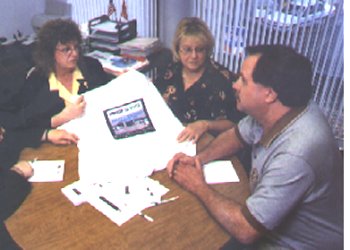|
|
Its floors show the grime and stains from spilled lubricants, solvents, coolants, disinfectants: a chemical stew that left its mark on floors, walls and ceilings. That witches’ brew left its mark on those who labored within the walls of the giant factory. During its heyday, more than 8,000 workers toiled here, churning out jet engines and powerplants for the nation’s aircraft and helicopter fleet. “We know of at least 60 people who have died from brain tumors,” reports Debra Belancik, chief safety representative for IAM Local 707. Most of them died from glioblastoma multiforma, a rare and aggressive cancer that strikes fewer than three in 100,000, according to medical studies. Yet Belancik and other IAM safety representatives say nearly 70 people have been diagnosed with the malady, all of whom worked at North Haven or other Pratt & Whitney locations in the area. In addition to Local 707, the spreading problem involves workers represented by IAM Locals 1746,1746A and 700. The victims worked at Pratt & Whitney sites for periods ranging from 12 to 40 years. The average was 12 years. “We’ve been asking questions about this since 1997,” Belancik said. When the company finally held a meeting with the victims’ families earlier this year, union representatives were barred from attending, she added. Belancik and other safety representatives say a variety of powerful chemicals used to clean and degrease turbine blades and other engine components filled the air with mists and vapors, mixing with metal dusts from the grinders. Workers seldom wore masks, respirators or other protective devices, she said. “They gave air filters to the machines,” noted Local 707 safety representative Gary Frattalone, pointing to a discarded and dirt-clogged filter propped against a wall. “Machines don’t breathe the air here. We do. They gave us nothing.” Under mounting pressure from the IAM and state officials, Pratt & Whitney officials hired Gary Marsh, a University of Pittsburgh biostatistician, and Nurtan Esmen, a University of Oklahoma professor of environmental and occupational health. The two experts found enough evidence to justify a study of Pratt & Whitney plants throughout the state. The study could take three to five years. Carol Shea and Kate Greco, the widows of two of the IAM members who died from glioblastoma, formed a group called Worked to Death. This advocacy group drew public attention to the critical health problems at Pratt & Whitney. “Every time we get a mention on television or in the newspaper, our phones ring off the hook,” Shea said. Both John Shea and John Greco worked at Pratt & Whitney for more than 35 years They were close friends. Mr. Greco, 62, died in April 2000. His friend, John Greco, died less than a month later. He was 56 years old. “His clothes reeked of the chemicals. He would come home covered with oil. His body was covered with sores,” Mrs. Shea said of her husband. Kate Greco tells a similar story. “He always smelled like a chemical bath,” she said of her late husband. “He wouldn’t wear his shoes in the house because they were so filthy, so black on the bottom.” The long-range study now underway has come under fire, since it is funded by Pratt & Whitney. “If there are closed-door meetings between the study team and the company, there’s at least the perception that Pratt & Whitney will be able to control the outcome,” noted Richard Gross, an occupational health lawyer who represents the Worked to Death members. The investigators face a monumental task. Pratt & Whitney once employed more than 50,000 workers during its heyday. That number is down to about 13,000 now. No one can say with any certainty how many may have passed through its doors since it opened in 1925.
|



